#Asahi Shimbun
Explore tagged Tumblr posts
Text

Weekly Manga Sekai no Ijin (週刊マンガ世界の偉人) / Asahi Shimbun Publications (朝日新聞出版) / 9th Jun 2013 issue (Featured historical figure: Vincent Van Gogh)
#educational manga#2010s manga#vincent van gogh#van gogh#asahi shimbun#issue month: june#週刊マンガ世界の偉人#朝日新聞出版
24 notes
·
View notes
Text

alain delon, tokyo, japan, 1963
87 notes
·
View notes
Text
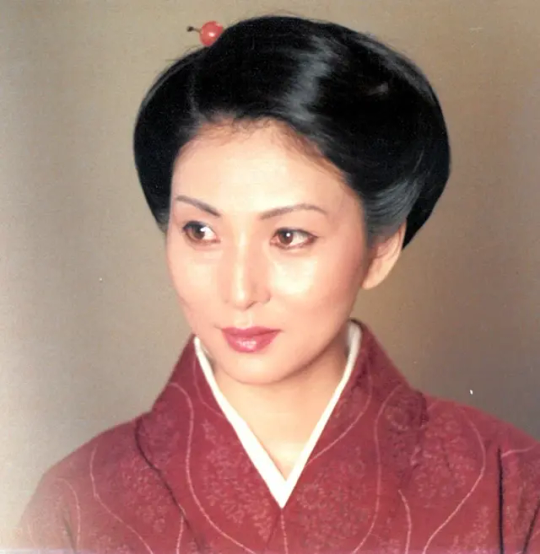
Meiko Kaji (梶芽衣子)
Taken from this recent, short Asahi Shimbun article regarding the re-issue of Meiko's LPs by WeWantSounds:
33 notes
·
View notes
Text
1939 film stars army dogs, the loyal, abandoned war combatants:The Asahi Shimbun
OTARU, Hokkaido–Hinomaru flags are waved and celebratory banners are displayed in a short wartime film starring relatively unknown combatants departing Japan for battlefields in China.
The one-minute movie for children was filmed 81 years ago and shows well-wishers seeing off a parade of dogs here in southern Hokkaido.
“Military dogs are performing distinguished service alongside troops,” the narrator in the film, titled “Gunyoken no Shussei” (Deployment of military working dogs), says. “This is a story about brave dogs that took off to battlegrounds from a city in Hokkaido.”
The Asahi Home Graph news film was one of 32 recordings that were returned to Japan. They were seized by U.S. occupation forces and taken to the United States after the end of World War II.

original link (borked): http://www.asahi.com/ajw/articles/AJ202001200006.html
2 notes
·
View notes
Text
Lai Dai Han (Lai Đại Hàn): The Truth that's Inconvenient for Korea (Essay)

Statue of Lai Dai Han
The 320,000 Korean troops sent to South Vietnam during the Vietnam War committed a war crime that will never be forgotten. Under the pretext of wiping out the Viet Cong in South Vietnam, they indiscriminately massacred local people and gang-raped women, causing countless children (5,000-30,000). These children are called "Lai Dai Han" (children of mixed race with Korean soldiers). They are not accepted in either Vietnam or Korea and live in discrimination.
In the extreme conditions of the battlefield, the true nature of human beings is revealed, but what about the wildness of these Korean soldiers? They are no less cruel than American or Russian soldiers. In Korea, the topic of Lai Dai Han is taboo, and although there were media outlets that tried to cover it, the Veterans' Association headed by former President Chun Doo-hwan (全斗煥) suppressed it. Chun Doo-hwan was the commander of the Vietnam Expeditionary Forces. Vietnam, which wants economic assistance from Korea, does not want to touch on the Lai Dai Han.
South Korea, which has committed such evil deeds, is persistently erecting statues of comfort women around the world to criticize Japan for the "comfort women issue," which is said that the Japanese military Kidnapped Korean women and made them "sex slaves", but this is ridiculous. In the first place, the "comfort women issue" is a fabrication by the Asahi Shimbun (newspaper) of Japan, and South Korea is just taking advantage of the situation of it. In the face of the Vicious Lai Dai Han issue, South Korea has no right to criticize anything including Japan. (The Japanese military consensually employed Korean women as prostitutes. Not sex slaves.) The UK has erected in Vietnam a statue of Lai Dai Han in front of the South Korean embassy to commemorate the evil deeds. Japan should also erect a statue of Lai Dai Han next to the statue of comfort women all over the world.
Rei Morishita
2024.07.21
ライダイハン:韓国にとって都合の悪い真実(エッセイ)
ベトナム戦争の折、派遣された韓国軍32万人は、決して消えない戦争犯罪を犯している。それは南ベトナムでベトコンを掃討する名目で、現地の人を無差別に虐殺、また女性を輪姦して夥しい数(5000-3万)の子供たちを生ませたことだ。この子供たちを「ライダイハン」(韓国兵との混血児)と呼ぶ。彼らはベトナムでも韓国でも受け入れらえず、差別されて生きている。
戦場という極限状態において、人間の本性があらわになるが、この韓国兵たちの荒みぶりはどうだろう。アメリカ兵、ロシア兵にも劣らない酷さだ。韓国では、ライダイハンの話題はタブーであるし、取り上げようとするマスコミはあったが、韓国大統領も務めた全斗煥を首魁とする退役軍��会が握りつぶした。全斗煥はベトナム派遣韓国軍の指揮��だった。韓国の経済的援助が欲しいベトナムも、ライダイハンには触れたくない。
こんな悪行をする韓国が、日本軍が朝鮮人女性を誘拐し「性奴隷」にしたとされる「従軍慰安婦問題」で、非難のため世界に慰安婦像をしつこく立てまくっているが、ちゃんちゃらおかしい。そもそも「従軍慰安婦問題」は日本の朝日新聞の捏造であり、それに韓国は乗っているに過ぎない。ライダイハンを前にすると、韓国がなにか非難する筋合いはない。(実際、日本軍は、合意の上で韓国人女性を売春婦として雇っていた。)イギリスは、ベトナムで、韓国大使館の前に、ライダイハン像を立て、その悪行を顕彰している。日本も従軍慰安婦像の隣に、ライダイハン像を立てるとよい。
#Lai Dai Han#Lai Đại Hàn#Korea#essay#rei morishita#Vietnam#children of mixed race with Korean soldiers#Chun Doo-hwan#全斗煥#Japan#comfort women#Asahi Shimbun#fabrication#UK#commemorate the evil deeds
3 notes
·
View notes
Text
THE ASAHI SHIMBUN
February 7, 2024 at 14:03 JST
Japan appears to be an exceptional case where the U.S. military has done almost nothing about cancer-causing organic fluorine compounds detected near U.S. military bases.
Perfluoroalkyl and polyfluoroalkyl substances (PFAS) repel water and oil and have been used in various products, such as firefighting foam.
The Okinawa prefectural government has detected levels of PFAS exceeding the temporary standards set by the Environment Ministry in tests conducted near U.S. Marine Corps Air Station Futenma in Ginowan, in the prefecture.
CONTAMINATED LAND
Masaru Miyagi, 59, who has farmed for many years in Okinawa, is angered by what he is seeing.
“The land and water on which I grew up has been polluted,” he said. “I have put up with the noise pollution from U.S. military bases as well as the crimes committed by personnel there, but I can no longer control my anger.”
Because Miyagi took pride in his organic farming produce, he is no longer growing anything now that the water has been found to be contaminated.
PFAS contamination first came to light in Okinawa in January 2016 when the Okinawa prefectural government announced the results of its study of rivers and water treatment plants around the U.S. Kadena Air Base.
One finding was that perfluorooctane sulfonate (PFOS), one of the PFAS compounds, was detected in the Chatan water treatment plant that provides water to about 440,000 locals. A maximum 80 nanograms per liter of water were found.
A river near Kadena Air Base had PFOS levels as high as 1,300 nanograms per liter.
Since 2016, the Okinawa prefectural government has made six separate requests at various U.S. military facilities to be allowed to investigate the cause of the contamination.
But the U.S. military has only allowed two on-site inspections because it admitted that accidents had occurred there. One involved 140,000 liters of firefighting foam leaking from the Futenma base in 2020.
Over the past eight years, the Okinawa prefectural government has spent a total of 3.2 billion yen ($21.6 million) to analyze and treat water contaminated with PFAS, of which the Okinawa Defense Bureau subsidized 1 billion yen.
The prefectural government believes at least 8 billion yen will be needed to deal with PFAS contamination over the next decade.
That means water bills in Okinawa will gradually increase by a total of 30 percent from October.
While part of the increase is due to rising consumer prices and to deal with aging water equipment, some of the money will also go toward combatting the PFAS problem.
Okinawa Governor Denny Tamaki has asked central government officials to shoulder the burden of managing the PFAS since the central government provides the facilities to the U.S. military from which the contaminant comes.
Masafumi Teruya is secretary-general of a citizens’ group seeking clean water around the Futenma base.
“It is unreasonable to have Okinawa residents pay to handle the PFAS,” he said.
5 notes
·
View notes
Text

3 notes
·
View notes
Text

Rogan Hazard, Illustration for Asahi Shimbun, "Muslim Immigrant Riots in Paris, France" April 2006.
"This was done in response to the (then) continuing riots in France. Intitially they were peaceful student marches that were quickly seized upon by Mulsim agitators as an excuse for general violence and destruction. I likened them, in their characteristic hooded sweatshirts, to a primitive beast out of the primordial past rampaging through the city."
4 notes
·
View notes
Text
Japan Issues Warning About Wandering Cat After Feline Falls into Toxic Chemicals and Escapes
New Post has been published on https://petn.ws/m0Owg
Japan Issues Warning About Wandering Cat After Feline Falls into Toxic Chemicals and Escapes
“If you find a cat that seems abnormal, please do not touch it and contact the city or police,” authorities told the public HANDOUT/Nomura Plating/AFP via Getty Footprints believed to be from a cat that fell into a tank containing toxic hexavalent chromium at the plating factory in Fukuyama, Hiroshima A cat fell into and […]
See full article at https://petn.ws/m0Owg #CatsNews #AsahiShimbun, #Fukuyama, #HexavalentChromium, #Hiroshima, #NomuraPlating, #SurveillanceFootage
0 notes
Text
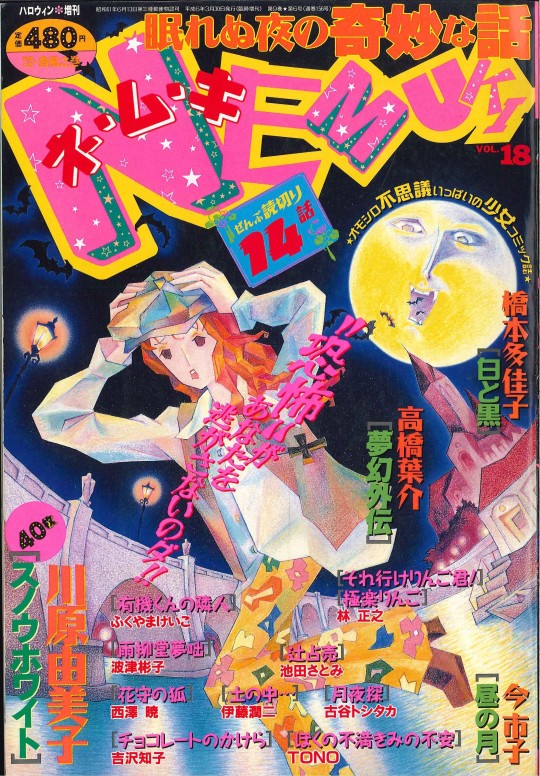
Nemuki (ネムキ) / Asahi Sonorama (朝日ソノラマ) / Mar 1994 issue
#shojo manga#retro shojo#90s manga#horror manga#asahi shimbun#asahi sonorama#admin fave#issue month: march#ネムキ#朝日ソノラマ
85 notes
·
View notes
Photo

alain delon, tokyo, japan, 1963
29 notes
·
View notes
Text
The criminal is still running away. The person who has committed the brutal act should come out if he or she has a conscience with a small courage. Violence is everywhere and it is even within us, but it's not everything. We live according to our morale and law for better in this society. We fight against violence for better and for us and others.
0 notes
Text
Apothecary Diaries[ character relationship] chart at newspaper Asahi Shimbun


#Apothecary Diaries[ character relationship] chart at newspaper Asahi Shimbun#kusuriyanohitorigoto#kusuriya anime#theapothecarydiaries#maomao#jinshi#love#maomao and jinshi#anime#jinmao#aesthetics#the apothecary diaries manga#the apothecary diaries#Knh#knh fanart#knhedit#knh spoilers#knh maomao#knh jinshi#knh anime#gaoshun#apothecary diaries#Light novel
33 notes
·
View notes
Text
Hachiko: The world's most loyal dog turns 100
2 July 2023
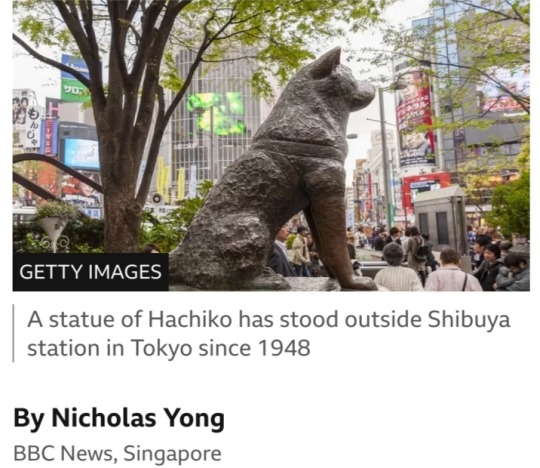
The Chinese tagline on the movie poster says it all: "I will wait for you, no matter how long it takes."
It tells the true story of Hachiko, the faithful dog that continued to wait for its master at a train station in Japan long after his death.
The cream white Akita Inu, born 100 years ago, has been memorialised in everything from books to movies to the cult science fiction sitcom Futurama.
And the Chinese iteration - the third after a Japanese version in 1987, and the Richard Gere-starrer in 2009 - is a hit at the box office.
There have been tales of other devoted hounds such as Greyfriars Bobby, but none with the global impact of Hachiko.
A bronze statue of him has stood outside Shibuya Station in Tokyo, where he waited in vain for a decade, since 1948.
The statue was first erected in 1934 before being recycled for the war effort during World War Two.
Japanese schoolchildren are taught the story of Chuken Hachiko - or loyal dog Hachiko - as an example of devotion and fidelity.
''Hachiko represents the ideal Japanese citizen with his unquestioning devotion," says Professor Christine Yano of the University of Hawaii - "loyal, reliable, obedient to a master, understanding, without relying upon rationality, their place in the larger scheme of things."
The story of Hachiko
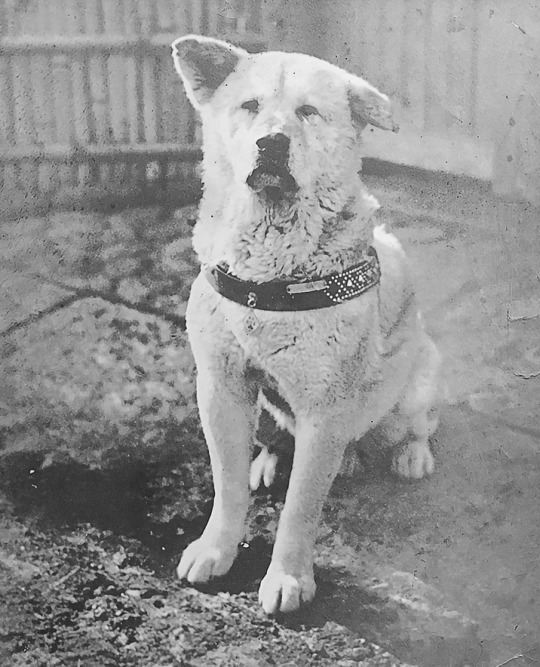
Hachiko was born on 10 November 1923 in the city of Odate in Akita prefecture, the original home of Akitas.
A large-sized Japanese dog, the Akita is one of the country's oldest and most popular breeds.
Designated by the Japanese government as a national icon in 1931, they were once trained to hunt animals like wild boar and elk.
"Akita dogs are calm, sincere, intelligent, and brave [and] obedient to their masters," said Eietsu Sakuraba, author of an English language children's book about Hachiko.
"On the other hand, it also has a stubborn personality and is wary of anyone other than its master."
The year Hachiko was born, Hidesaburo Ueno, a renowned agricultural professor and a dog lover, asked a student to find him an Akita puppy.

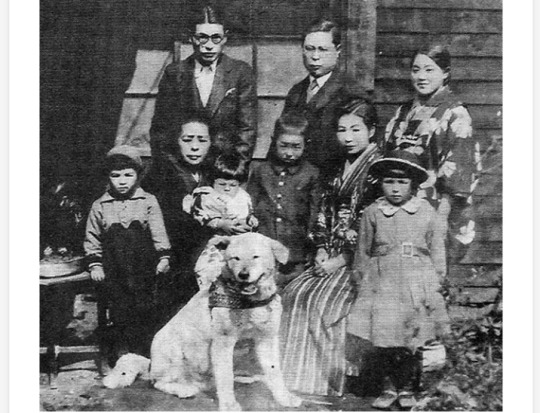
After a gruelling train journey, the puppy arrived at the Ueno residence in Shibuya district on 15 January 1924, where it was initially thought dead.
According to Hachiko's biographer, Prof Mayumi Itoh, Ueno and his wife Yae nursed him back to health over the next six months.
Ueno named him Hachi, or eight in Japanese. Ko is an honorific bestowed by Ueno's students.
The long wait
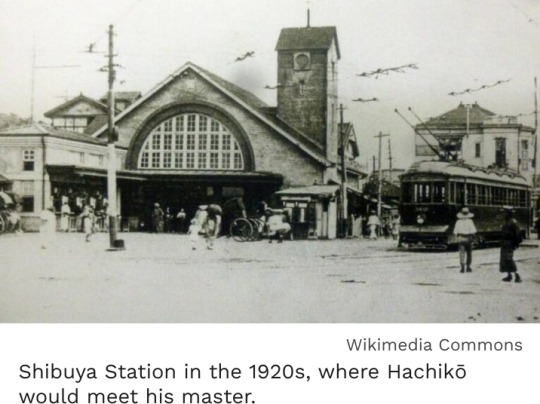
Ueno took a train to work several times a week. He was accompanied to Shibuya station by his three dogs, including Hachiko. The trio would then wait there for his return in the evening.
On 21 May 1925, Ueno, then 53, died of a cerebral hemorrhage. Hachiko had been with him for just 16 months.
"While people were attending the wake, Hachi smelled Dr Ueno from the house and went inside the living room. He crawled under the coffin and refused to move," writes Prof Itoh.
Hachiko spent the next few months with different families outside Shibuya but eventually, in the summer of 1925, he ended up with Ueno's gardener Kikusaburo Kobayashi.
Having returned to the area where his late master lived, Hachiko soon resumed his daily commute to the station, rain or shine.
"In the evening, Hachi stood on four legs at the ticket gate and looked at each passenger as if he were looking for someone," writes Prof Itoh.
Station employees initially saw him as a nuisance. Yakitori vendors would pour water on him and little boys bullied and hit him.
However, he gained nationwide fame after Japanese daily Tokyo Asahi Shimbun wrote about him in October 1932.
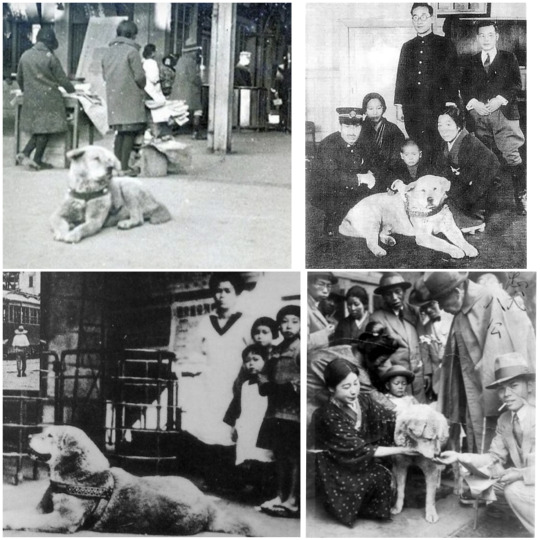
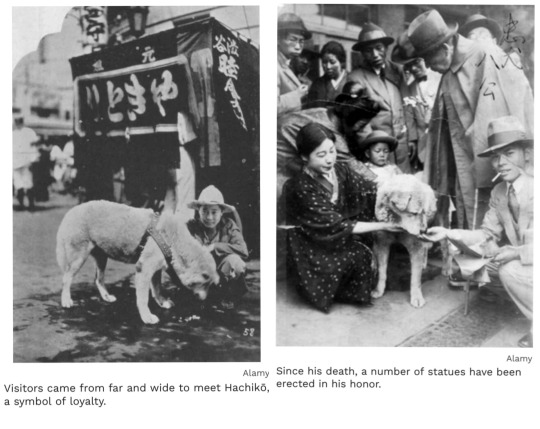
The station received donations of food for Hachiko each day, while visitors came from far and wide to see him.
Poems and haikus were written about him. A fundraising event in 1934 to make a statue of him reportedly drew a crowd of 3,000.
Hachiko's eventual death on 8 March 1935 at the age of 11 made the front page of many newspapers. He was found on a street in Shibuya.
In March 2011, scientists finally settled the cause of death of Hachikō: the dog had both terminal cancer and a filaria infection.
There were also four yakitori skewers in Hachikō's stomach, but the skewers did not damage his stomach nor cause his death.

At his funeral, Buddhist monks offered prayers for him and dignitaries read eulogies. Thousands visited his statue in the following days.
In impoverished post-war Japan, a fundraising drive for a new statue of Hachiko even managed to raise 800,000 yen, an enormous sum at the time, worth about 4bn yen (£22m; $28m) today.
"In retrospect, I feel that he knew that Dr Ueno would not come back, but he kept waiting - Hachiko taught us the value of keeping faith in someone," wrote Takeshi Okamoto in a newspaper article in 1982.
As a high school student, he had seen Hachiko at the station daily.
Remembering Hachiko
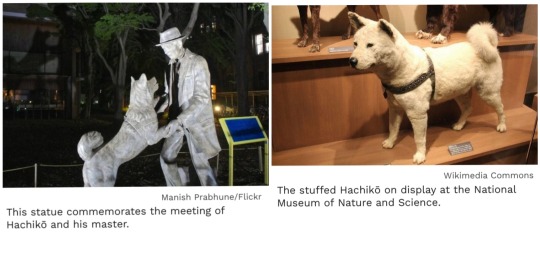
Every year on 8 April, a memorial service for Hachiko is held outside Shibuya Station.
His statue is often decorated with scarves, Santa hats and, most recently, a surgical mask.
His mount is on display at the National Museum of Nature and Science in Tokyo.
Some of his remains are interred at the Aoyama Cemetery, alongside Ueno and Yae.
Statues of him have also been cast in Odate, Ueno's hometown Hisai, the University of Tokyo and Rhode Island, the American setting for the 2009 movie.
Odate also has a series of events lined up this year for his 100th birthday.
Will the world's most loyal dog still be celebrated a century from now? Prof Yano says yes because she believes the "heroism of Hachiko" is not defined by any particular period - rather it is timeless.
Mr Sakuraba is equally optimistic.
"Even 100 years from now, this unconditional, devoted love will remain unchanged, and the story of Hachiko will live on forever."

🤍🐕🤍
#Hachiko#Akita Inu#Greyfriars Bobby#Shibuya Station#Tokyo#Japan#Chuken Hachiko#loyal dog Hachiko#dogs#animals#animal love#Akita prefecture#Odate#Hidesaburo Ueno#Tokyo Asahi Shimbun#Prof Mayumi Itoh#Kikusaburo Kobayashi#Takeshi Okamoto#April 8#National Museum of Nature and Science#Aoyama Cemetery#Akita#Hachiko @100#loyal dog
46 notes
·
View notes
Text
An Idiot on War and Peace (Essay)

F16
A Japanese blogger wrote: "If Japan declares neutrality, it will receive weapons from both the USA and China." After reading this statement, I banned this person from my blog. The chairman of the Japan Socialist Party made the outrageous argument of "unarmed neutrality," but "If we remain unarmed neutral, will China give us weapons?" - the result would be that Japan would be invaded by force.
In the power-driven international situation, the blogger in question sees nothing. He is too optimistic and unrealistic. This man graduated from Tohoku University, a prestigious university in Japan, and was an avid reader of the Asahi Shimbun (Newspaper). He is a kind of elite, but the Asahi Shimbun is tricky. It is a Japanese opinion magazine, but this newspaper regards "Article 9 of the Japanese Constitution, a war-renunciation article imposed by GHQ," as its golden rule, and has been working hard to denigrate Japan since WWII.
This newspaper denies the military that Japan should naturally have as an independent nation, just as GHQ says, and its ultimate goal is the eventual downfall of Japan. In an international society filled with malice, it is dangerous to place expectations on the conscience of other countries. The Asahi Shimbun is defenseless against China, and the same goes for progressive politicians who use this logic. Only by being fully cautious about other countries, we Japanese can be safe.
Rei Morishita
2024.06.25
戦争と平和に関するバカ(エッセイ)
日本のブロガーで、このように書く人がいた:「日本が中立を宣言すれば、USAからも中国からも武器を貰える。」私はこの発言を読んで、私はこの人を、私のブログに出入り禁止にした。日本社会党の委員長には「非武装中立論」という暴論を吐いた人もいるが、「非武装中立を保てば、中国が武器をくれるか?」―日本が武力侵攻されるのが落ちであろう。
パワー本位の国際情勢の現実の中において、例のブロガーは何も見ていない。楽天的すぎて非現実的である。この男、日本では優秀な大学である東北大学を卒業し、朝日新聞を愛読していた。一種のエリートなのだが、この朝日新聞というのが曲者だ。日本のオピニオン誌なのだが、この新聞は「GHQに押し付けられた、戦争放棄の条文―日本国憲法第9条」を金科玉条とし、WW2後、日本を貶めることに腐心してきた。
日本が独立国として当然持つべき軍隊をGHQの言う通りに否定し、ゆくゆくは日本の滅亡を最終目的に据えている新聞なのである。悪意に満ちた国際社会において、他国の良心に期待するのは危険だ。朝日新聞は、中国に対して無防備であり、この論理を援用する革新系政治家も同様だ。他国には、十分に警戒心を持ってこそ、安全が手に入る。
#Idiot#War and Peace#essay#rei morishita#unarmed neutrality#Asahi Shimbun#Article 9 of the Japanese Constitution#GHQ
1 note
·
View note
Text
Uruma residents unconvinced by briefing on new SDF training site
THE ASAHI SHIMBUN
URUMA, Okinawa Prefecture—The Defense Ministry tried to reassure residents here about safety and other issues concerning a planned new Ground Self-Defense Force training site, but the explanation was met largely with skepticism.
The ministry held a briefing session for about 280 residents on Feb. 11 about the project planned in their city. Local neighborhood associations, concerned about noise and accidents, have already demanded that the plan be scrapped.
The GSDF training site, adjacent to a residential area, will be part of the “southwest shift” of Japan’s defense capabilities, with China in mind.
The ministry said it will buy a 20-hectare former golf course in fiscal 2024, conduct a survey design in fiscal 2025, and start construction for the GSDF training site in fiscal 2026.
The acquisition cost was included in the proposed budget for the new fiscal year and communicated to the Uruma city and Okinawa prefectural governments. The budget amount has not been disclosed because negotiations with landowners are pending.
The planned site is designed for helicopter operations and training of new SDF members. They will not be firing live ammunition.
“We will do our best to minimize the impact on the surrounding area,” Defense Minister Minoru Kihara said at a news conference.
During the briefing, ministry officials emphasized that “no U.S. military training is envisioned,” and that helicopters will only fly in time of disaster or emergency.
Some residents raised questions.
One said: “It is strange to give an explanation after the planning decision has been made. Will the residents’ opinions be reflected from now on?”
Another resident criticized the ministry’s explanation as “completely unreliable,” citing the fact that its plan to deploy missile and other units at a GSDF garrison in Yonaguni, Okinawa Prefecture, was decided after the coastal surveillance unit was set up.
The development of the Uruma training site was initiated after three revised security-related documents were issued in December 2022. The documents included a policy to upgrade the Naha-based 15th Brigade, with about 2,000 personnel, to a division with more SDF members.
“In terms of defense strategy, it is highly significant to have a training site near the troops,” a senior ministry official.
However, the planned site is surrounded by residential neighborhoods and a prefectural youth facility, where elementary, junior high, and high school students stay and study.
In January, two local neighborhood associations passed a resolution opposing the construction of the training site, citing concerns about noise and accident risks associated with helicopter drills.
A council consisting of 15 neighborhood associations in the former Ishikawa city also unanimously voted against the project.
A 71-year-old resident who lives nearby said the training site “will destroy our lives.”
“The noise and accidents caused by the U.S. military alone are unbearable, and it is outrageous that the SDF will further increase the burden with the base,” he said.
The planned site is also in the district of Miyamori Elementary School, where 18 people, including children, were killed when a U.S. military jet crashed in 1959, before Okinawa’s reversion to Japan.
Many people still remember the tragedy.
The 71-year-old man was a first-grader in the area at the time.
“Every time there is an accident involving the U.S. military, it brings back memories of those days. I fear that the same thing may happen again,” he said.
In addition, a surface-to-ship missile unit will be deployed in March at the GSDF Vice Camp Katsuren in Uruma, located about 15 kilometers southeast of the new training site.
Deployment of long-range missiles at the site, for possible strikes against enemy bases that are attacking Japan, is also being considered.
The ministry said it has not yet decided on the deployment site for such missiles. But some Uruma residents are concerned the area may become a target of other countries in the event of a military emergency.
Uruma Mayor Masato Nakamura has yet to indicate his approval or disapproval of the planned GSDF training site.
Some Uruma city assembly members affiliated with the Liberal Democratic Party are sympathetic to the neighborhood associations.
Transcending party lines, a group of city assembly members plans to submit a petition opposing the project to the February assembly session.
In recent years, the GSDF has opened garrisons in the Sakishima isles, including on Yonagunijima, Miyakojima and Ishigakijima islands.
Okinawa Governor Denny Tamaki said such moves make “the people of the prefecture feel danger and anxiety.”
Regarding the new training site in Uruma, Tamaki urged the ministry and the GSDF to “show respect for the wishes of the local community.”
(This article was written by Kaigo Narisawa and Satsuki Tanahashi.)
3 notes
·
View notes